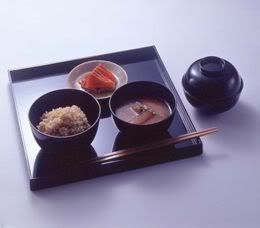this is from the site wanogakkou^^

Reproductions of tea-ceremony dish of Rikyuu
Traditional Japanese Dishes
The Three Fives
Japanese cuisine is rich in variety, encompassing everything from the simplest home-cooked meal to special meals for ceremonial occasions and fabulous banquets Japanese food popular overseas includes sushi, tenpura, and sukiyaki, but these have fewer traditional elements than do ceremonial and banquet menus.
The Japanese diet is commonly said to consist of five flavors, five colors, and five basic methods of preparation. These are the five flovors of sweet, sour, hot, bitter, and salty; the five colors of white, yellow, re, green, and black; and the five preparations of raw, boiled, grilled, deep-fried, and steamed. Japanese foods are prepared to retain as much of their natural flavor as possible, and great importance is placed on the delicacy of color, fragrance, and taste. Seasonality is also stressed, with foods being served at their peak season. Serving dishes play an important role; their color, shape, and material being carefully matched to the food and season.
Traditional Japanese Cooking
While there are far too many kinds of traditional Japanese cooking to list them all, some of the best-known are:
・Honzen-ryouri Originally a formalized mothod of presenting food to guests in the samurai homes of the feudal Muromachi period, honzen-ryouri is served today only on such ritual and ceremonial occasions as weddings, funerals, and other formal occasions. Still, honzen-ryouri remains a basic influence in all traditional Japanese cooking styles and manners.
・Cha-kaiseki This is a simple meal served to guests before serving tea. The term kaiseki referring to the warmed stones that Buddhist monks ussed to put next to their stomachs to ward off hunger, the name connotes a frugal meal. This is also called kaiseki-ryouri.
・Kaiseki-ryouri This is a much more relaxed and informal banquet style than honzen, and may be thought of as the typical Japanese party menu. Much of the food served at the modern Japanese-style restaurant is in the kaiseki mode.
・Shoujin-ryouri Abstaining entirely from the use of any meat or fish, shoujin-ryouri is an all-vegetarian diet of soybean products, vegetables, seaweed, and rice. The two best-known schools are the shoujin-ryouri of Zen Buddhism and the fucha-ryouri served at the Zen Oubakusan Manpukuji.
・O-sechi-ryouri This is the festive food eaten at New Year's, and it is often served in a five-layer set of lacquer boxes. In olden times, o-sechi-ryouri was used to refer to the food prepared as offerings to the gods on special occasions.